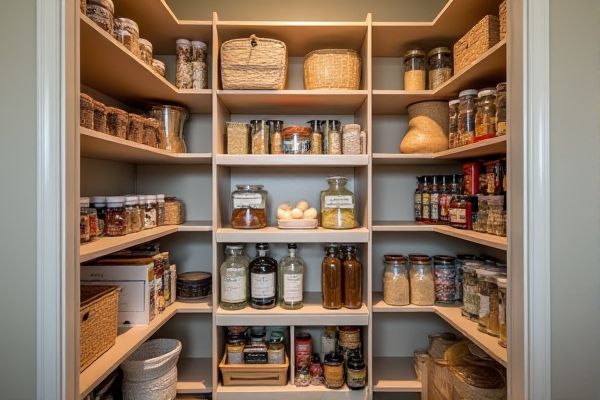
A lazy Susan pantry maximizes corner space with rotating shelves, offering easy access to items and reducing clutter compared to a straight shelf pantry that provides a traditional, linear storage layout but may have less efficient use of corner areas. Discover which pantry style best suits Your kitchen needs and storage preferences by reading the rest of this article.
Table of Comparison
| Feature | Lazy Susan Pantry | Straight Shelf Pantry |
|---|---|---|
| Storage Accessibility | 360deg rotation for easy access to items | Items stored in a line, requiring reach or rearranging |
| Space Utilization | Maximizes corner spaces | Optimal for straight wall spaces |
| Visibility | Full view of contents via rotation | Limited visibility to front items |
| Installation Complexity | Requires special hardware and measurements | Simple installation with standard shelves |
| Cost | Generally higher due to mechanisms | Usually more cost-effective |
| Maintenance | Needs occasional lubrication and motor check (if motorized) | Low maintenance, easy cleaning |
| Use Case | Best for corner pantries and maximizing awkward spaces | Ideal for wide, straight pantry spaces |
Lazy Susan Pantry vs Straight Shelf Pantry: An Introduction
Lazy Susan pantries optimize corner space with rotating shelves, providing easy access to stored items and minimizing clutter. Straight shelf pantries offer a traditional, fixed shelving system ideal for organizing larger or taller items but may require more frequent rearranging to reach items at the back. Your choice depends on the kitchen layout and how efficiently you want to utilize storage capacity.
Space Efficiency: Comparing Storage Capacities
Lazy Susan pantries maximize corner space utilization with rotating shelves, offering up to 20-30% more accessible storage compared to straight shelf pantries. Straight shelf pantries provide organized, tiered storage but often leave corner areas underutilized, reducing overall capacity. The circular design of Lazy Susans ensures items are easily reachable, enhancing storage efficiency in compact kitchen layouts.
Accessibility: Which Pantry Offers Easier Reach?
A lazy Susan pantry enhances accessibility by allowing you to rotate shelves, making items in the back easy to reach without bending or stretching, ideal for maximizing space in corner cabinets. In contrast, a straight shelf pantry offers straightforward visibility but may require you to move items to access those at the rear, which can be less efficient in deeper shelves. Your choice depends on whether you prioritize effortless rotational access or prefer the simplicity of straight-line organization.
Organization and Item Visibility Differences
Lazy Susan pantries enhance organization by utilizing rotating shelves that maximize corner space and allow you to access items without digging through layers. Straight shelf pantries offer simpler, linear storage but can lead to items at the back becoming hidden or forgotten, reducing overall visibility. Your choice influences how easily you can find and maintain order among pantry staples.
Installation Requirements and Flexibility
Lazy Susan pantry installation requires a rotating turntable mechanism and sufficient corner clearance, making it ideal for maximizing space in corner cabinets. Straight shelf pantries demand simpler installation with fixed shelving but offer less flexibility for storing varied item sizes. Your choice depends on available cabinet space and the need for adaptable storage configurations.
Maintenance and Cleaning Challenges
Lazy Susan pantries require regular cleaning due to their rotating mechanism, which can accumulate crumbs and spills in hard-to-reach corners. Straight shelf pantries offer easier access and straightforward cleaning, with flat surfaces that can be quickly wiped down without disassembling components. However, the deeper shelves of straight pantries may trap dust and debris, necessitating periodic thorough cleaning to maintain hygiene.
Cost Comparison: Initial and Long-Term Expenses
Lazy Susan pantries generally have a higher initial cost due to their rotating mechanism and hardware, while straight shelf pantries are more budget-friendly upfront given their simpler construction. Over time, Lazy Susans can reduce costs associated with wasted food by improving visibility and access, potentially extending the life of your groceries. Your long-term expenses may also include maintenance for the Lazy Susan's moving parts, whereas straight shelves typically require minimal upkeep.
Suitable Pantry Sizes and Layouts
Lazy Susan pantries are ideal for corner spaces in medium to large kitchens, maximizing accessibility and storage efficiency by utilizing otherwise hard-to-reach areas. Straight shelf pantries suit narrow, tall kitchens or walk-in pantries where linear shelving allows easy visibility and organization of items. Choosing between these pantry types depends on kitchen layout, available space, and preferred storage accessibility.
Best Uses: What Items Suit Each Pantry Type?
Lazy Susan pantries excel at storing small to medium-sized items like spices, canned goods, and baking supplies, allowing easy access and visibility with a simple spin. Straight shelf pantries are ideal for larger items such as cereal boxes, tall bottles, and bulk containers, providing straightforward organization and ample horizontal space. Each pantry type optimizes storage efficiency based on the size and frequency of access for household goods.
Pros and Cons Summary: Making the Right Choice
Lazy Susan pantries maximize corner space with rotating shelves, offering easy access to stored items but may limit storage height and require regular cleaning. Straight shelf pantries provide simple, unobstructed storage with adjustable shelves, accommodating various container sizes but can create hard-to-reach areas in deep corners. Your decision depends on kitchen layout, storage needs, and ease of access preferences to balance convenience and capacity.
 homyna.com
homyna.com